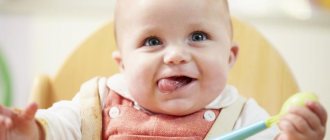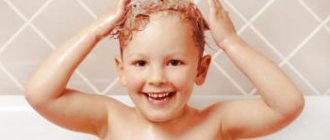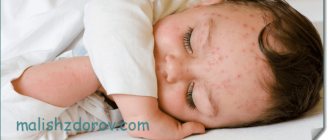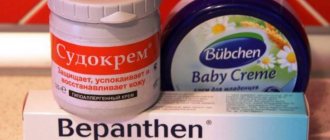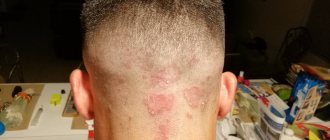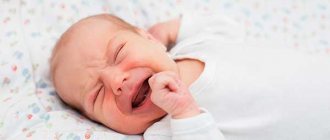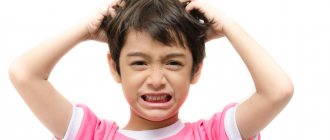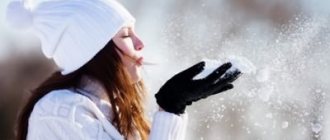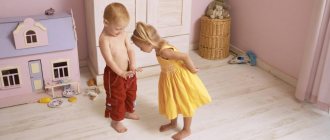Features of the disease
Seborrhea is an inflammatory process involving the sebaceous glands. It can be of allergic and non-allergic origin. The cells of the sebaceous glands, sebocytes, produce the skin's fatty secretion - lard. The appearance of crusts is due to the fact that yeast-like fungi from the Malassezia furfur family settle on the surface of the skin, which actively feeds on the products of the sebaceous glands. One of the varieties causes seborrhea of the scalp, the other - the rest of the skin.
Photo of seborrhea in children on the head
In infants, the epidermis is still poorly developed, and the work of the sweat and sebaceous glands is just being adjusted. Most often, the sebaceous glands work too actively, and the sweat glands are not yet enough. As a result, the skin becomes easily vulnerable to any factors, including infections and various fungi.
What are seborrheic crusts?
Seborrheic crusts are a type of dandruff.
In an adult, its appearance is provoked by dry skin on the head; in children, it appears due to excessive secretion and accumulation of sebum.
The localization of the crusts is fronto-parietal, but since the sebaceous glands are located throughout the body, their appearance can be found on the eyebrows, behind the ears, on the temples and even on the cheeks of the toddler.
When a lot of scales accumulate, a crust forms and looks like a yellow cap. The common people called this problem “baby’s cap.”
Causes of crusts
Experts have not yet definitively decided what causes seborrheic dermatitis in infants. However, the main reasons are believed to be:
- non-compliance with nutritional rules;
- overheating of the skin;
- sweating;
- reaction to hygiene products;
- failure to comply with hygiene rules.
One version says that the activation of the sebaceous glands in the first weeks of life is caused by androgens hormones that entered the child’s body during pregnancy. The process of removing hormones and, accordingly, normalizing the functioning of the sebaceous glands takes some time. During this period, the baby develops milky crusts on the skin.
Overheating of the scalp due to improperly selected clothing and increased sweating leads to the fact that fungal pathogens begin to multiply on the baby’s skin, which cause inflammation. The colonization of the skin occurs immediately after the birth of the child. However, fungi do not normally cause skin damage. And only when it is weakened, crusts appear.
Immaturity of the digestive system also provokes the development of dermatitis. While the body does not produce enough enzymes, new foods can cause skin rashes. A lack of vitamins B and PP in breast milk can lead to the baby suffering from the appearance of milk crusts.
Using shampoos that are not age appropriate can also cause inflammation of the skin. Some parents become overly zealous about hygiene, washing their child’s hair every day. In this case, even the use of the most gentle means will cause seborrhea. Rare washing is also unhealthy and causes exactly the same symptoms.
Sometimes seborrhea in infants is provoked by infectious diseases suffered by the mother during pregnancy, various congenital anomalies, pathologies and immaturity of the gastrointestinal tract.
In children over 2-3 years old, crusts on the head can cause:
- allergic reactions;
- stress;
- medications;
- eating disorders;
- dysbiosis and malabsorption of nutrients in the intestine;
- Rarely washing your hair or using detergents that are inappropriate for your age.
In adolescence, seborrhea of the scalp is caused by:
- Hormonal changes.
- Stress.
- Diseases of the gastrointestinal tract.
- Poor nutrition.
At any age, overheating of the skin causes activation of the sebaceous glands. This inevitably leads to the appearance of crusts.
Heredity plays virtually no role. Numerous studies have shown that the appearance of crusts in a newborn has no connection with whether his parents had similar phenomena in childhood.
What enhances the formation of gneiss?
- Tendency to allergies. When a child is prone to diathesis and other manifestations of allergies, his immunity is weaker than usual. Therefore, crusts on the head may not go away for a long time.
- Overheating. Imperfect thermoregulation is not able to withstand overheating of the skin, and the heat exchange process is more difficult. It is especially bad when a child wears a cap for 24 hours in the summer. There is no need to cover the baby's head if you are at home or outside, it is hot, accompanied by a slight breeze.
- Frequent washing. If you are a supporter of washing your baby’s hair every day with all kinds of shampoos, then know that in this way you are more likely to dry out the baby’s delicate skin, which only mobilizes the work of the sebaceous glands, and the crusts grow more intensely.
- Unsuitable hygiene products. Not all shampoos and foams for washing hair are suitable for your baby, even if they are marked “from birth” or “hypoallergenic”. And remember, even if the product is suitable, the baby’s head is washed once, maximum twice a week.
Symptoms
In the photo there are crusts on the baby's head
The leading symptom is the appearance of greasy yellowish or whitish crusts on the scalp. They can be located in patches or cover the entire surface of the scalp. The scab consists of a large number of scales resembling dandruff. Sometimes seborrheic dermatitis can affect the folds of the limbs, abdomen, eyebrows, and groin area.
A scab can appear as early as 2-3 weeks of a child’s life. Sometimes they spread to the eyebrows, forehead, behind-the-ear areas, and cheeks. The scales are easily separated from the skin. In children over 3 years old, seborrhea can occur in oily, dry and mixed types. With the oily type, the scales form crusts around the hair follicles. When dry, they are scattered over the entire surface of the head, forming grayish crusts. In this case, the hair underneath breaks and falls out. In adolescence, these two forms combine with each other, forming a mixed one.
Important: Unlike other types of skin lesions, seborrheic dermatitis does not cause itching, discomfort, pain or irritation.
If the scales are difficult to separate, and wounds remain after them, then there is a completely different skin lesion that requires special treatment. Since infant seborrheic dermatitis does not cause itching, there should be no scratching. If they are present, most likely it is a seborrheic type of atopic or allergic dermatitis. Seboric dermatitis differs from psoriasis in that psoriasis has a rash that is not covered with scales.
With a mild course, there are only crusts on the head. In moderate cases, lesions appear on other parts of the body. In severe cases, desquamative erythroderma may develop, which will cause developmental delays and diarrhea.
How to remove lep from a child
After a couple of unsuccessful attempts to “wash off” the milky crusts from the baby’s head, some parents give up on the problem. They say, the time will come - they will disappear on their own. This is the wrong approach, since crusts prevent the scalp from breathing and hair from growing. That is why careful care of the scalp is needed so that the baby does not have problems with hair in the future .
In general, crusts on the head (popularly called lep) appear due to increased secretion of the sebaceous glands. As a rule, they appear in the crown area, but they can also appear in other parts of the head. Lep persists in babies for several months, and only with proper care leaves the baby alone forever.
Having noticed a mold on a baby, under no circumstances should you rip it off his head . You risk damaging your baby's skin. But you still won’t be able to get rid of them completely. In addition, the risk of infection in this area of the head increases. In addition, these crusts must not be allowed to harden, otherwise it will be extremely difficult to remove them. It is important to take action as soon as you discover lepography in your baby.
Treatment of seborrheic crusts in children
Scabs on the head look untidy and frighten parents, but they are completely harmless to the child’s health. There is an opinion among people that if the scab is not removed, then the child’s hair will not grow. This is wrong. Seborrheic dermatitis does not damage the hair follicles in any way.
Classic seborrheic dermatitis in infants goes away on its own by three months, or in extreme cases by six months to a year. However, this does not mean that there is no need to fight scabs, because an untidy appearance of the head does not make a child look good. Moreover, in large quantities, crusts can already cause discomfort.
You cannot pick out the crusts and comb them out with sharp combs. This can damage the skin and cause infection.
The easiest and most effective way is combing. To do this, two hours before the expected time of bathing, the crusts are generously lubricated with oil. This can be a special oil for baby skin care or any vegetable oil, preferably olive or almond. Next, a cap is put on the baby’s head. In 2 hours the crusts become soft.
During bathing, wash your hair as usual. Then the skin is blotted and the crusts are carefully combed out with a comb with blunt rounded teeth. To wash your hair, you can use special shampoos to remove crusts. Mustela and other manufacturers have such lines. If there are a lot of crusts, then the next bathing the procedure will have to be repeated. The hair of older children can be washed with antiseborrheic agents such as Nizoral, Quelual. Among the folk remedies, but very effective, we can recommend tar soap.
As a rule, drug treatment is not required. Only in severe cases after four years can fluconazole or metronidazole be used. No pills are prescribed in preschool age. If the course is prolonged, older children may benefit from Zinocap and Pimafucort ointments.
Treatment
Treatment of seborrheic crusts can be carried out at home independently, without the use of medications.
You can also use special products designed to eliminate scaly formations after consulting a pediatrician.
Pediatric doctors most often prescribe foams or shampoos for infants.
The product should be applied to areas covered with crusts, slightly foamed and massaged into the skin for three to four minutes, after which you can bathe the baby and pat the hair dry with a towel.
The most popular drugs for seborrheic crusts are shampoos: Kelual D.S., Nizoral, Friederm tar and others.
Sometimes, with large areas of damage, shampoos may not give the desired result. In this case, after consultation, the doctor may prescribe treatment with ointment for seborrheic dermatitis. Thanks to its texture, the product is well absorbed and effectively fights dry crusts.
Modern manufacturers have also developed a cream for scalp crusts, which acts quickly and relieves the baby of scaly formations in the shortest possible time.
Prevention
In order to get rid of seborrheic dermatitis or prevent its development, you must follow some rules. First of all, there is no need to bundle up your child or put clothes on him that are out of season. Secondly, walks and air baths will be useful. Thirdly, bed linen should be cotton or linen, pillows should be made of natural materials.
Antihistamines and antibacterial drugs, antifungal ointments, together with vitamin complexes, are used for chronic forms of seborrheic dermatitis in children over 4-5 years of age and in adolescents.
When a doctor's help is needed
Despite the safety of scales for the baby’s health, you should consult a pediatrician if:
- It is not possible to get rid of crusts on your own for 2 or more weeks;
- The baby experiences a painful reaction when touching the scales;
- Weeping areas appear on the surface of the head and forehead, and exudate is released;
- The area covered with crusts gradually increases.
- Gneiss covers the baby's shoulders, neck, and forehead.
The doctor will determine the reasons for the deterioration of the situation, promptly determine the onset of inflammatory, fungal, and infectious diseases, and prescribe appropriate medications. If you have an allergy, your doctor will help you identify the allergen and recommend a hypoallergenic diet.
Forecast
Seborrheic dermatitis in infants, as a rule, goes away without a trace and does not lead to allergic diseases in the future. If it is detected in children over 7 years of age, it can then be complicated by atopic dermatitis, allergic reactions or erythroderma. But in most cases, with adequate therapy, skin problems completely disappear by adulthood.
Scalp problems occur frequently in children. You shouldn’t be afraid of this: these layers look unsightly, but do not cause much discomfort to babies. However, they need to be treated to prevent the disease from developing. To do this, you first need to find out the reasons for the appearance of crusts on the head.
Preventive measures
What else will help get rid of milk crusts faster? Here are some recommendations:
- Give your skin a chance to breathe. Spending some time naked is very beneficial. Do not overuse the wearing of caps and caps unless necessary.
- Reduce the room temperature. Everyone knows that to maintain health, the optimal temperature in a children's room should be close to 20 OC, and humidity levels should be kept at approximately 60-70%. Modern devices such as air conditioners and humidifiers can become your faithful assistants if used correctly.
- For children - children's cosmetics. Don't try to save money on baby shampoo. Subsequently, you can spend a lot more money on treating allergic diseases.
Crusts on a child’s head: causes
The main reason for the formation of crusts is the so-called seborrheic dermatitis. Children's skin is very delicate, so they are prone to skin disorders. In young children, the sebaceous glands are actively working and do not sweat enough, but as the baby grows, the situation normalizes.
Seborrhea often occurs in infants, but sometimes children under 14 years of age also suffer from it. It can be caused by various factors:
- Fluctuations in hormonal levels.
- Hereditary predisposition (sometimes this disease can be transmitted from parents).
- Lack of vitamins in the body, especially vitamin B.
- Disorders of the nervous system or thyroid gland (in older children).
- Overheating of the head or, conversely, hypothermia.
The reasons for the development of seborrhea should also be looked for among the products that are used to wash the child: they may contain allergic additives.
As for the lesions, they can occur in different ways, since they depend on the location of the sebaceous glands. Depending on the form of seborrheic dermatitis, your baby may also develop bald spots or red spots.
Crusts on the head of a 5 year old child
It also happens that children do not have crusts in infancy, but later, for example, at the age of five, they appear. Such peeling is very frightening for caring parents, but they can occur for natural reasons.
Their appearance can be caused by poor hygiene, disruption of the sebaceous glands caused by infectious diseases of the mother during pregnancy, or problems with hormones. Usually the crust is very dense and has a gray or yellowish tint. You should not try to remove it so as not to damage the skin.
The best way to deal with the problem is to use well-sterilized oil, which you need to carefully lubricate the affected areas, then put on a cap and leave for 15-20 minutes. Vaseline or salicylic ointment are also suitable for this purpose. At the end of the procedure, you need to wash the child’s hair well and remove the remaining crusts. A comb made of natural material with sparse teeth is suitable for combing, and you can remove any remaining crusts with a soft brush.
How to remove crusts on a child's head
The main way you can’t do without in the fight against scabs is combing. In addition, you will need a special product, such as a children's exfoliating cream. The child's head should be washed well, patted with a towel and applied to the entire surface of the head. The cream should be left on the head overnight under a cap made of natural material. In the morning, you should comb out all the crusts well, rinse and dry your hair.
If this does not help, it is better to consult a doctor who will examine the child and prescribe therapeutic treatment.
To avoid relapse, great attention should be paid to the prevention of dermatitis. Try using a special antiseborrheic shampoo, it helps reduce the activity of the fungus and relieve skin inflammation.
You should also avoid washing your hair too often. This causes dry skin, which activates the sebaceous glands and can cause thickening of the crusts.
Do not wrap children too much in warm clothes when this is not necessary: sweating can trigger the development of seborrhea.
It is very important to regularly examine the child’s head for peeling, itching, and allergic reactions. Together with your pediatrician, you should select a good drying cream for your child.
Since the appearance of dermatitis is sometimes associated with allergies, it is recommended to create a special diet. It is necessary to exclude from the menu foods that cause a negative reaction in the body: fatty foods, sweets, flour. It is imperative to increase your consumption of foods containing vitamins A, B and C.
Timely treatment and regular prevention will help your child get rid of this disease.
Why does a crust appear on a child's head? This question worries parents. Many mothers are upset when they see a greasy yellow crust on the crown of their baby. The layering peels off, sticks to the hair, but is quite easily removed. People call this condition “cradle cap,” but the official name is seborrheic dermatitis. A crust on a child’s head is nothing more than a severe form of dandruff. The child does not feel discomfort, but parents are worried, as dermatitis spoils the baby’s attractiveness.
Why do crusts form on a child’s head? Sometimes seborrheic dermatitis can cover the entire scalp of a baby, spreading to the face, ears, nose, armpits and groin areas. Everywhere except the head and eyebrows, the condition is called seborrheic eczema.
Why does a crust appear on a child's head? This question worries parents. Many mothers are upset when they see a greasy yellow crust on the crown of their baby. The layering peels off, sticks to the hair, but is quite easily removed. People call this condition “cradle cap,” but the official name is seborrheic dermatitis. A crust on a child’s head is nothing more than a severe form of dandruff. The child does not feel discomfort, but parents are worried, as dermatitis spoils the baby’s attractiveness.
Why do crusts form on a child’s head? Sometimes seborrheic dermatitis can cover the entire scalp of a baby, spreading to the face, ears, nose, armpits and groin areas. Everywhere except the head and eyebrows, the condition is called seborrheic eczema.
How to remove a crust from a baby’s head at home: how to comb it, remedy
Some conditions of a newborn baby cause particular concern for parents, although in fact there is no reason for concern. Thus, infants under the age of three months often develop a crust on the head.
People call it “birth mud” or “milk crust”; doctors use the term “seborrheic dermatitis” or “gneiss”.
In most cases, this condition does not require treatment and goes away on its own as the baby gets older.
A crust on the head is observed in every third child aged 1-3 months
Seborrheic crusts in a child under one year old
Infants often develop dirty gray crusts on the scalp and behind the ears. Parents usually rush to clean it up. According to pediatricians, this condition is not considered a pathology, and it is not necessary to remove the scab. Here are the main causes of seborrhea in young children:
- Imperfect functioning of the sebaceous glands;
- Difficulty in adapting the child’s body to new conditions;
- Allergic reactions to breast milk or formula;
- Hereditary predisposition to excessive sebum production (so-called “oily skin”).
Seeing a dirty gray coating on a child’s head, parents often begin to worry and intensively treat the child with various folk remedies to cleanse the skin. However, such help is not necessary - gneiss usually does not cause any discomfort to the newborn and does not lead to disruptions in the functioning of the child’s body.
Birth dirt, like childhood intestinal colic, is just a baby’s reaction to changing living conditions. Don’t forget that the baby spent 9 whole months in the mother’s belly, so the newborn period is an active adaptation of the body to new conditions, a new type of breathing and nutrition.
Pediatric seborrheic dermatitis is quite common.
Symptoms of birth dirt
What can cause diarrhea in a baby?
The so-called “birth dirt” usually appears as a gray or dark yellow, light brown crust. It is especially noticeable if the baby has light sparse hair, and is practically invisible under dark, thick hair. These are soft, small crusts that resemble fish scales.
If you pry such a “scale” with your fingernail, it can be easily removed; there is clear skin underneath. However, this should not be done to avoid infection. To remove birth dirt, only medicinal and cosmetic products can be used.
An effective way to mechanically remove scales is to comb them out with a wooden or plastic comb.
Fighting gneiss at home
Constipation in a baby while breastfeeding - what to do
If crusts appear on a baby’s head, your pediatrician will tell you how to remove them. There are several ways to combat infantile seborrhea, for example:
- Special creams;
- Shampoos for newborns;
- Treatment of gneiss with sterilized sunflower oil;
- Mechanical removal using a comb.
Modern pediatricians do not recommend spending time and money on fighting seborrhea.
If an adult can comb out the scabs from the baby's head, they will soon reappear; This will continue until the child’s body fully adapts to the new conditions and until the functioning of the sebaceous glands improves.
In addition, in some cases, seborrheic dermatitis is caused by allergies; in this situation, only switching to a new formula or changing the diet of the nursing mother can help.
You should purchase medicinal and cosmetic products to get rid of scabs only in licensed pharmacies, as prescribed by a doctor. It is strictly forbidden to use hormonal ointments; they can only be used with a prescription from a pediatric allergist.
To combat gneiss at home, you can use children's cosmetics
Medicines and cosmetics
To remove gneiss at home, modern manufacturers of children's medicines and cosmetics produce special creams, shampoos and baby oils.
When using these products, you must strictly follow the instructions. In most cases, it is necessary to apply a little cream (oil) to the baby’s head and put on a cap.
When the time recommended in the instructions has passed, the child’s hair is thoroughly washed, and the crust is removed on its own, without additional combing.
When choosing, it is recommended to give preference to brands of domestic cosmetics. Gneiss removal products and “Eared Nannies” are very popular.
Among foreign products, it is worth noting BabyBorn baby oil, widely recommended by pediatricians. This product quickly and effectively helps remove birth dirt, allowing baby's skin to breathe freely.
Also, BabyBorn oil does not cause allergic reactions and is suitable for sensitive skin.
Combing
It is strictly forbidden to scratch off the scabs on a dry head. This may cause pain and irritation to the baby.
Before you begin removing gneiss, you need to apply a little boiled vegetable oil to the scalp; You can also use Vaseline.
After this, the baby is put on a flannel cap for an hour and given a bath, washing his hair with baby shampoo. On steamed skin, the crust softens and comes off on its own; To remove it, just run a soft-toothed comb through your hair.
Important! You should not use a metal comb, because the iron teeth can easily damage the skin on the baby’s head.
It is most convenient to clean the gneiss when the baby is sleeping or lying on his stomach. If the child is awake, he should be calm and in a good mood. Usually the baby tolerates this procedure well, feeling virtually no pain or discomfort. If there are a lot of crusts on the head, combing out is a rather lengthy process.
It happens that individual scales do not soften and cannot be combed. In this case, they should be left as is. The main thing is to wash your child’s hair more often, and they will gradually disappear on their own. It is prohibited to forcefully clean the crusts with a comb or brush, rubbing the skin.
Attention! If your baby has long hair, it needs to be cut short before combing out the scabs. However, there is no particular point in this - under long hair the gneiss is practically invisible. The main thing is to keep your hair clean. If a child scratches his head frequently, he may damage the skin underneath the scabs.
What you should absolutely not do
Diarrhea in infants while breastfeeding
Pediatricians categorically prohibit:
- Use any folk remedies to remove gneiss without prior medical consultation;
- Touch the crusts on the child’s head with dirty hands and peel them off by prying them off with your nails;
- Scratch the child's skin with hard objects;
- Use sunflower oil to soften the crust without sterilizing it first.
You should not smear the scalp with creams and oils too often, otherwise the skin will breathe poorly and it will be even more difficult to get rid of the milky crust.
It is strictly forbidden to use bath or toilet soap intended for adults to wash a baby’s hair. It contains a lot of alkali and dries out sensitive skin.
An ideal option for daily bathing is baby soap, shampoo for babies up to one year old, or a special foam.
Dr. Komarovsky says: if a baby has a lot of crusts on his head, you need to make sure that the child does not overheat.
Excessively warm clothing and elevated room temperatures make the skin dry and often lead to the formation of large amounts of gneiss. If the house is warm, the baby should keep his head uncovered at all times.
You need to put on the cap only after swimming, until your hair is completely dry. Preference should be given to chintz bonnets; flannel bonnets - children often get hot.
Don't let your baby scratch his head frequently.
Complications caused by seborrhea
Infantile seborrhea sometimes causes serious complications. The most common of them are:
- The appearance of ulcers as a result of skin infection;
- Dryness and irritation of the skin;
- Chronic eczema and dermatitis, difficult to treat;
- The appearance of a large number of small ulcers and wounds on the baby’s head and torso.
Fortunately, such complications occur quite rarely. To prevent their appearance, you should carefully monitor the condition of children's skin, especially on the head and behind the ears, where it is most sensitive to mechanical stress. If any crusts, ulcers or rashes occur, you should show your baby to a doctor.
The most dangerous complications can arise if pathogenic microbes get into the wound under the “birth dirt”.
To prevent this, parents should touch the child's head only after thoroughly washing their hands. The same should be required from a doctor or nurse examining a baby at home.
Seborrhea can cause severe skin irritation in children
When to see a doctor
It happens that a baby develops a scab not only on his head, but all over his body. Typically, this condition indicates a food allergy or individual intolerance to formula milk, so consultation with a doctor is recommended.
You should also visit a pediatrician if your baby often scratches and scratches his head - perhaps the scabs are causing him discomfort. Sharp redness of the skin covered with gneiss is also a serious cause for concern. A change in skin color may indicate penetration of pathogenic microbes. If measures are not taken in time, the child may develop blood poisoning.
Attention! If the skin is hot and dry in the place where the birth dirt is located, this indicates an infection has penetrated inside. In this case, you must immediately consult a doctor. The child may be prescribed a local or general antibiotic to eliminate the inflammation.
Development of the disease
Seborrheic dermatitis is very common in infants younger than 8 months. Most often, unaesthetic yellow crusts appear on the baby’s head in 1-2 months of life. The medical name for “cradle cap” is gneiss. The disease lasts from several weeks to several months.
Parents sometimes discover oily layers under the hair of children of preschool and even primary school age. Although it looks unsightly, it does not harm the child, there is no itching or other discomfort. However, attempts to remove the crust in children over 3 years of age give the child unpleasant sensations.
Doctors distinguish three degrees of development of the disease: mild, moderate and severe. The latter is usually combined with the child’s general poor health - dysbacteriosis, vomiting, anemia, insomnia. This condition is observed in children deprived of normal care.
Main reasons
Causes of seborrhea:
- Action of maternal hormones. These substances remain in the child's body from the prenatal period. They increase sebaceous secretions, and dead skin cells stick together on the crown of the head.
- Hereditary allergies, especially such as eczema.
- Dysbacteriosis. Gastrointestinal disorders provoke malfunctions of the sebaceous glands.
- Development of yeast fungus on the scalp.
- Lack of vitamin B in the body.
- Difficult pregnancy of a mother with metabolic disorders.
- Maternal use of antibiotics during pregnancy.
- Poor hygiene, insufficient child care.
- Poor living conditions - dust, gas pollution, etc.
- Wrong clothes. Too warm hats or wearing a hat in a heated room cause severe sweating of the scalp.
- Wrong selection of shampoo.
Seborrhea in children and adolescents
Dermatologists distinguish 4 types of seborrhea in children:
- Fat. Large flakes of dead skin and sebum stick together at the roots of the hair. In infants, with careless care, this form leads to the development of fungal infections. Teenagers can suffer from both oily seborrhea and acne.
- Dry. Individual skin particles are scattered over the entire surface of the head. They stick together into yellow or gray crusts. May be accompanied by a reddish rash on the body and loss of some hair.
- Mixed. A combination of two forms: on the hair - dry, on the skin of the face - oily. Not observed in infants and children under 13 years of age;
- Physiological. It is typical for adolescents, and, as a rule, is a continuation of the “cradle cap” in infancy.
Treatment methods
Mothers of infants are wondering whether seborrheic crusts need to be removed? In addition to aesthetic reasons, there is also a health problem. The accumulation of fat deposits on the scalp isolates the skin from air, causing hair roots to suffer. To prevent your child from having brittle, sparse hair in the future, it is necessary to periodically clean his head of deposits.
https://youtu.be/Cr1zIK36Huo
Methods for removing crusts:
- Wash your child's hair regularly. Do not use regular baby shampoos. Pharmacies sell special anti-seborrhea products, for example, La-Cri, Emolium. These shampoos contain no dyes or perfumes. They are created using a special “no tears” technology and can be used for babies from the moment of birth. The healing ingredients of shampoos are salicylic acid, coal tar, zinc. The shampoo should be left on the hair for 2 minutes and then rinsed off.
- After washing, you need to rub baby oil, almond oil or just vegetable oil into your baby's skin. If the crust on the head has become very hard, you can leave the oil overnight. In the morning, loose flakes are cleaned with a soft brush.
- Baths with medicinal herbs - chamomile, string, nettle - are useful if the child does not have allergies.
- Coconut oil has a very good effect. This product does not require preheating. You need to remove the oil from the refrigerator, leave it at room temperature for half an hour and rub a small amount into the baby’s scalp before bathing;
- Tea tree oil has a similar effect.
- You can lubricate the baby's head with Vaseline.
- Many mothers use their own breast milk as a means of softening the crusts. It should be applied to the child's head before bathing.
- Any oil must be washed off very carefully. Excess of it can worsen the condition;
- All hygiene procedures should be carried out no more than 2 times a week.
- Do not remove scales from the baby’s head with a fingernail or other hard objects. Sometimes the seborrheic film sticks to the head too tightly. Picking can damage your baby's delicate skin, causing infection and inflammation.
Olive oil should not be used to lubricate the baby's head. Its smell may irritate the baby. For children over 3 years old, you can take olive oil and use it at night.
You should act very carefully in the fontanelle area. To remove crusts, pediatricians advise using a special baby comb with short, fine teeth.
Cleansing the head should be done when the baby is in a good mood and smiling. Seborrheic crusts do not bother the baby, but the removal procedure is not very pleasant for him.
If the skin under the cradle cap is red and swollen, the child should be taken to the doctor. An even more serious condition is bleeding cracks, a rash on the head spreading to the face, and a rise in temperature above 37°. This may indicate exposure to an infection. Your doctor will prescribe an antifungal cream or a course of antibiotics.
Seborrheic dermatitis may disappear and return within a few months. Preventive measures should be carried out for several months after the child has recovered.
How to get rid of crusts
What happens if the baby's gneiss is not touched? Actually, it's okay. The time will come, and the crusts will disappear on their own (unless, of course, there are allergic problems). But few parents are ready to look at them every day. Purely for aesthetic purposes, most people strive to get rid of gneiss as quickly as possible. Well, it is quite possible to speed up the process, but you need to do it correctly.
Combing correctly
In order to comb out the leopard, purchase a special comb with natural bristles and a plastic comb with blunt, fine teeth from the pharmacy. On the day when you plan to bathe and wash your hair, the scalp is lubricated with oil 40-60 minutes before water procedures, and a cotton cap is put on.
Seborrheic dermatitis in children over one year of age
As a rule, the milk crust disappears forever after 4 months of life. But sometimes such problems remain or fade away for a while, recurring after a year. There are known cases of seborrhea at 4, 5 and even 10 years of age.
If the baby suffered from this disease after six months, parents should carry out preventive procedures from time to time. The most important of them is preventing the development of yeast fungus on the scalp. To do this, you should always have Sabulex or Nizoral medicated shampoo in your bathroom. Once a month you should wash your hair with an antiseborrheic agent.
You should consult a doctor if:
- parents discovered crusts in the child after a year;
- the baby often scratches his head;
- large greasy scales are noticeable on the hair.
This condition can be caused by a bacterial infection. In this case, the child is prescribed penicillin antibiotics, injections of vitamin B and glucose. Ascorbic acid is also useful for boosting immunity. Topical treatment may include steroid creams or antifungal ointments. Zinc ointment is useful, as it dries and relieves inflammation.
Scabs on a child’s head go away without any complications if the parents provide the child with proper hygienic conditions. But they can be the first signals of serious metabolic problems, such as psoriasis, atopic dermatitis, and diathesis.
If crusting is combined with abnormal weight gain, Leiner's disease may be suspected. Attentive parents should show their child to specialists in a timely manner if his condition deviates from the norm.
When you need a doctor's help
If the gneiss stubbornly does not go away, look for the reason. It could be a fungal infection or atopic dermatitis. Review your diet if you are breastfeeding.
You should definitely consult a doctor if you have the following signs:
- within a week of trying to get rid of gneiss there are no changes;
- the child tries to scratch the scabs and becomes irritable;
- scales become wet;
- crusts grow;
- the scales peel off and spread throughout the body.
As you can see, gneiss in newborns is not as terrible as it seems at first. It is associated with the physiological characteristics of the infant period and passes without a trace over time. But sometimes you need to consult a doctor so as not to miss a disease that can masquerade as milk crusts.
After the baby is born, parents examine every centimeter of his body every day, studying possible changes. Particular attention is focused on the baby's head, where most newborns develop a lep .
These crusts on the head bother many parents. Moms and dads try to rid the baby of this “decoration” as quickly as possible. However, it is very important to take precautions so that the baby does not get hurt.
